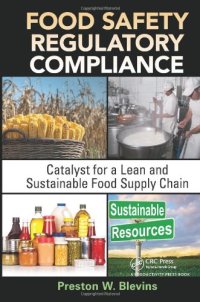
Ebook: Food safety regulatory compliance : catalyst for a lean and sustainable food supply chain
Author: Preston W Blevins
- Series: Series on resource management
- Year: 2013
- Publisher: CRC Press
- City: Boca Raton, Fla
- Edition: 1
- Language: English
- pdf
The global sourcing of ingredients has created complex supply chains, significant management challenges, and additional regulatory compliance requirements. This places tremendous pressure on food manufacturers, many of whom lack the knowledge, concepts, techniques, and procedures to comply with these increased requirements. Providing a roadmap for leveraging existing investments in food safety regulatory compliance into superior inventory management, Food Safety Regulatory Compliance: Catalyst for a Lean and Sustainable Food Supply Chain explains how to implement Lean operating principles to determine what needs to be improved, in what sequence improvements must be addressed, how one improvement feeds another, and the prerequisites for each improvement.
Based on the author’s experience working with hundreds of manufacturers, the book discusses cause-and-effect thinking, data accuracy, process simplification, process reliability, and workforce development. It includes how-to recommendations for implementing best practices to achieve these goals. These recommendations come together in the discussions on Batch-Process ERP (Enterprise Resource Planning) and also the Lean Management System and the useful techniques within it. The author also discusses the rapidly developing business requirement of sustainability, which is quickly moving from an optional, voluntary, and "nice to do" status to a "must do" status.
The book can be read in whole or in part by everyone from the CEO to the factory floor supervisor; the language is nontechnical. But, to aid comprehension, each chapter concludes with an extensive quiz, and the appendix has definitions that will be new vocabulary for many. Normally large companies have the resources to fund the implementation of best practices, smaller companies less so. This book benefits both. In the case of the small- to medium-size manufacturer, it is a roadmap, and for the major corporation it is a tool to help assist their supplier community. It can help any organization achieve world-class excellence in operations and supply-chain management.